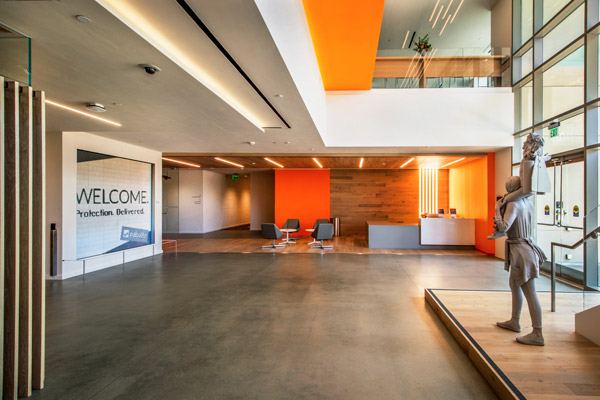When Palo Alto Networks opened its new corporate headquarters on September 21, 2017, there was a buzz of excitement in the air. Employees and their families walked the lush green campus, decorated with colorful balloons, and local dignitaries milled about as they waited to attend the ribbon-cutting ceremony. A great deal of work went into that day of celebration, and Tom Willow and his team were instrumental in making it happen.
Willow came to Palo Alto Networks with extensive experience working for companies during periods of growth, which meant that he was exactly the right man for the job: the next-generation security company was rapidly expanding. To that end, Willow, vice president, global workplace resources, has grown his team from five to thirty-four people during his tenure. Expanding the team was a necessity to accommodate for “the physical security, health, and safety of all our employees at all our locations globally,” he explains.
Shortly after he arrived at Palo Alto Networks, Willow and his newly expanded team were tasked with finding a solution to an ongoing challenge for the company caused by their rapid growth: the company would soon outgrow its current headquarters in Santa Clara, California. The team developed a plan, and Willow met with the board of directors in May of 2015 to present a proposal for a new corporate headquarters. The board of directors approved, so Willow and his team got to work.
To take on a project of this size, Willow says, “you have to have the right internal organization, then you need the right partners to support you: managers, architects, consultants, acoustics, food service, security. Identifying that team was crucial to the success of the project.”

From the beginning of the development process, it was crucial that the new headquarters be “all under one roof.” This philosophy is a major part of the culture at Palo Alto Networks, particularly as it continues to expand. Fitting all of the company’s employees into the same physical space is crucial when it comes to “making sure that everybody’s on the same page, hearing the same message, and marching to the same drum,” Willow explains.
Construction began on the new headquarters in July 2015, but the old offices were quickly running out of space, so the company needed to find a solution. Palo Alto Networks ended up renting a nearby interim office building, or “swing space,” for the duration of construction. Willow and his team were able to use the swing space as a testing ground for their eventual permanent home. With the blessing of executive management, they tested everything from furniture, to workspaces, to lighting, to ceiling heights in the 120,000 square foot space.
This testing ground provided some valuable insights about what would work best for the headquarters’ final design. When it came to furniture, “one size doesn’t fit all,” Willow says. “An engineer works differently than a marketing professional, who works differently than a sales professional.” To that end, Willow and his team developed “a kind of Lego kit of parts we can scale up or down without disrupting the overall layout of everything.” The marketing department, led by the CMO, who Willow notes is passionate about office design, helped Willow and his team test out ceiling heights, and they eventually decided upon an open-ceiling design.
Another decision that was made partially due to their experiences in the swing space was to organize every floor of the building around the same focal point: the kitchen. “Having the kitchen and some meeting space off the main elevators bank on each floor was something that we tested in the swing space and everybody loved it,” Willow says. “It’s kind of like a person’s house—everything always happens in the kitchen. There’s a lot of collaboration in our industry, and that collaboration can happen in the kitchen.”
The testing process in the swing space was hugely beneficial, but Willow points out that many other companies would never have let it happen in the first place. “The executive management team gave us the opportunity to test these things out so that we got it right. A lot of companies would say ‘No, we’re not going to do that,’ but they saw the value in getting buy-in,” he says.
When it came time to make final design decisions, Willow and his team got feedback from across the company about what each department would need in the new space. “We told them to take a long-term view on it. What will you need in ten years?” Willow says.
Throughout the design process, Willow and his team presented their recommendations to a steering committee comprised of the company’s top executives. “It was a very collaborative process between the architect, the client, project managers, the executives, and even the employee base,” he says.
Palo Alto Networks employees moved into the new headquarters in August 2017, and have been blown away by the new campus’s amenities. The campus, which occupies 1 million square feet in total, has four main buildings housed on twelve acres. There are over 600 customized spaces for collaboration, ranging from huddle rooms to board rooms. There is a variety of food options, from a large marketplace, to a coffee shop, to a bistro, and a 20,000-square-foot fitness center (which has already achieved 50 percent employee participation). There are even 100 charging ports for electric cars—and if all of this sounds daunting, not to worry: a GPS system helps employees and visitors find their way.
Based on the reactions of Palo Alto Networks employees to their new headquarters, all of Willow and his team’s hard work has paid off in spades. “What our team wanted throughout the process was for everyone to see the campus and say ‘Wow,’” he says, “and I’ve gotten that from employees—and from a recruitment standpoint, too.” All of these dazzling amenities are in support of the company, Willow says, and the effects have already been visible. “There’s kind of a collegial buzz in the air, and people have a little more jump in their step.” That spring in the employees’ step is understandable—now they have everything they need, under one roof.


